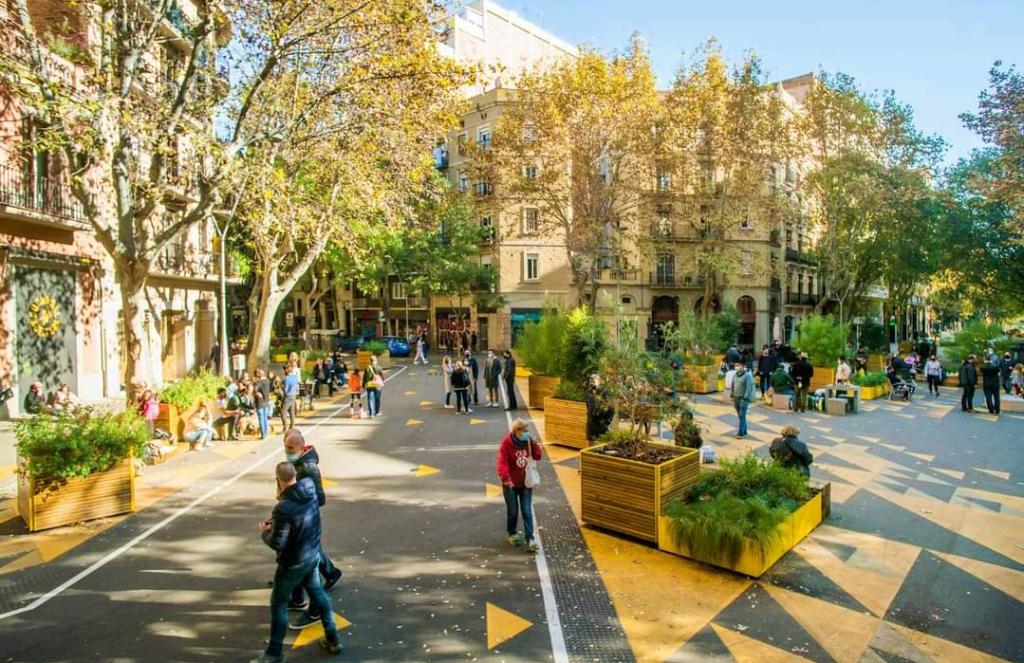Thessaloniki gets ready for its metro launch in November
The underground rapid transit lines have been under construction for almost two decades due to various project delays
 TheMayor.EU logo
TheMayor.EU logo 
Green oases will spring up in Barcelona's L’Eixample district, Source: Ada Colau via Gergely Karácsony
Following the green transformation of several neighbourhoods, the Superilla Barcelona scheme will move on to L’Eixample district, with work starting in June 2022
Say Barcelona and conjure a sprawling, sun-bathed city with endless beaches, Modernista architecture punctuated by Gaudi landmarks and mouth-watering cuisine. An almost perfect picture, had it not been for one thing - the unrelentingly heavy car traffic and the ensuing noise and pollution. The majority of Barcelona inner city areas regularly exceed WHO nitrogen dioxide limits of 40 micrograms per cubic metre, with fine particulate matter also above the norm.
According to 2020 data, Barcelona had 6,000 private cars per square km, the highest number among EU cities. And while cars proliferate, pedestrian and community public spaces dwindle at a fast rate. How is Barcelona coping with this problem?
In 2000, the new city leadership headed by pro-independence mayor Ada Colau launched a 10-year plan to create green zones in the heavily polluted central L’Eixample district and other areas. These peaceful oases in a bustling city do not ban, but discourage car use, giving priority to walkers and cyclists.
The scheme, conceived back in 2016 and now radically extended, was dubbed Superilla or Superblock, evoking the grid of straight avenues and octagonal blocks created by urban planner Ildefons Cerdà who shaped L’Eixample’s modern outlook in the early 20th century.
Addressing the environmental concerns of the 21st century, the plan puts several city blocks in a cluster, closing them off to through-traffic with the help of low-cost interventions: potted plants, picnic tables, and benches installed at spaces used for parking. The green zones come also equipped with children’s playgrounds and fountains, as well as cycling lanes cutting through.
Despite the opposition of car lobbies, the Superblocks plan received widespread public support. And following the creation of green zones in a number of neighbourhoods such as Sant Antoni, Poblenou and Horta, the municipal government announced last week that it was moving on to L’Eixample, the district with the most pollution and fewest public spaces.
Works are set to begin in June 2022. The initial projects, including the creation of four large and 31 smaller squares, as well as four green streets, are worth EUR 52.3 million.
Starting with the four streets - Rocafort, Comte Borrell, Girona and Consell de Cent - a new street model will be implemented in all transformational projects across Barcelona. The concept envisages fostering everyday life in public spaces, stimulating sustainable mobility and local commerce, while simultaneously reducing car noise and pollution.
Here is what the new street model entails:
The four streets and squares are just the first stage in the major facelift to L’Eixample which will see 21 green streets and 21 large squares created by 2030.
The Superblock scheme (to borrow the words of Budapest Mayor Gergely Karácsony) is Barcelona’s latest international export product, which many other cities are already trying to emulate. Karácsony was captivated by the model’s efficiency during a recent visit to Barcelona in the framework of the Pact of Free Cities. Consequently, he announced on his Facebook page that for the first time this year, the Municipality of Budapest will issue a call for tenders, inviting non-governmental organizations to come up with ideas for the creation of green zones in the Hungarian capital.
Discover the planned transformation in our Gallery above.

The underground rapid transit lines have been under construction for almost two decades due to various project delays

Now you can get your wine in Talence by paying directly in Bitcoin

That’s because the state has to spend money on updating the railway infrastructure rather than subsidizing the cost of the popular pass

Rethinking renewable energy sources for the urban landscape

The examples, compiled by Beyond Fossil Fuels, can inform and inspire communities and entrepreneurs that still feel trepidation at the prospect of energy transition

Now you can get your wine in Talence by paying directly in Bitcoin

The 10th European Conference on Sustainable Cities and Towns (ESCT) sets the stage for stronger cooperation between the EU, national and local level to fast track Europe's transition to climate neutrality.

At least, that’s the promise made by the mayor of Paris, Anne Hidalgo

The underground rapid transit lines have been under construction for almost two decades due to various project delays

At least, that’s the promise made by the mayor of Paris, Anne Hidalgo

Hostal de Pinós is located in the geographical centre of the autonomous region

Despite its church-y name, the district has long been known as the hangout spot for the artsy crowds

Urban dwellers across the EU are having a say in making their surroundings friendlier to people and the environment.

Forests in the EU can help green the European construction industry and bolster a continent-wide push for architectural improvements.

Apply by 10 November and do your part for the transformation of European public spaces

An interview with the Mayor of a Polish city that seeks to reinvent itself

An interview with the newly elected ICLEI President and Mayor of Malmö

A conversation with the Mayor of Lisbon about the spirit and dimensions of innovation present in the Portuguese capital














